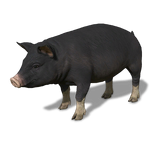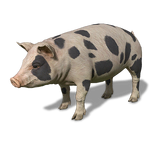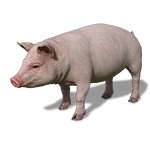How to Feed Pigs Farming Simulator 19

The in-game icon for Pigs.
Pigs are a type of Animal in Farming Simulator 19. Various Crops can be fed to Pigs to make them breed at a very high rate compared to other animals. Excess pigs can then be sold for a substantial (and very stable) income that is completely independent of any market fluctuations.
Pigs are fairly expensive animals, costing $1500 a piece (not including transportation costs). The smallest Pig Enclosure available in the base game costs $90,000, and can hold up to 100 pigs. It is generally a good idea to start with just a handful of Pigs, since they can quickly breed on their own to fill the entire enclosure.
The primary product of Pigs is more Pigs. Breeding only occurs when the Pigs are supplied with Water and any of eight different types of food. Pig breeding rates depend mainly on which variety of foods is provided to them, with Corn giving a large breeding speed bonus; Wheat or Barley giving a moderate bonus; Canola, Soybeans or Sunflowers giving another more modest bonus; and a small optional bonus for Potatoes or Sugar Beets. Providing Straw to the pigs and keeping their feeding area clean increases productivity even further.
Instead of feeding individual Crops to pigs, it is possible (though expensive) to purchase Pig Food Pallets from the Store - a perfect mix of all foods needed to reach the highest breeding rate.
At 100% productivity, Pigs breed at a rate of one pig per 145 hours divided by the number of pigs of the same color in the same enclosure. Keeping animals at a exactly 100% productivity is extremely difficult, so a single pig should be expected to reproduce every 150 hours under realistically-ideal conditions. Pigs stop breeding if there is no room in the enclosure for more pigs, or if they run out of food or water. Each pig sells for $1000 (not including transportation costs).
As by-products, Pigs also produce Slurry from Water, and Manure from Straw. They do not need to be provided with any food in order to produce these materials at the maximum rate. Since pigs can quickly reach their maximum population if properly fed, a Pig Enclosure can easily become a very abundant source of Slurry and Manure.
The base game provides 4 different types of pigs, each with a different color. All types of pigs function identically, though keeping only one color of pig in each enclosure helps maximize the breeding rate.
List of Pigs
Farming Simulator 19 offers 4 different types of Pigs. These can all be bought at the Animal Dealer. There is no functional difference between any of the different types of pigs, only physical appearance.
| Name | Price |
|---|---|
 | 1,500 |
 | 1,500 |
 | 1,500 |
 | 1,500 |
Pig Enclosure
- Main article: Pig Enclosure (Farming Simulator 19)
Before purchasing any Pigs, you must purchase at least one Pig Enclosure from the Store. This is a Placeable that can be placed on any sufficiently-large open space (no obstacles).
The base game provides two different models of Enclosures. The only real difference between them is their capacity (the number of pigs they can hold), and their physical size.
Once the Pig Enclosure is placed on the map, you can begin to fill it with Pigs and their required materials.
Purchasing Pigs
To purchase pigs, visit the Animal Dealer and interact with its sale point ![]() Open Animal Dialogue Default Buttons:
Open Animal Dialogue Default Buttons:  R
R  ??
??  ?? . This will only work if you own at least one Animal Pen, otherwise the menu will not open.
?? . This will only work if you own at least one Animal Pen, otherwise the menu will not open.
After pressing the button, if you have more than one Animal Pen, you'll be asked which pen you'd like to populate. You must select an existing Pig Enclosure in order to purchase Pigs. If you do not own such an Enclosure, you will only be able to purchase other animals.
Breeding Pigs
The primary purpose of Pig Husbandry is to create more Pigs and sell them for a profit. Pigs breed extremely quickly when provided with all of the necessary materials, and sell for a hefty sum.
At the bare minimum, pig breeding requires at least one Pig, provided with Water and at least one type of food. Pigs can eat 8 different Crops, with each crop providing a different effect on the breeding speed. Providing four different crop types for the pigs to eat simultaneously will maximize their breeding speed. Additional Straw bedding increases the breeding rate further, as does keeping the Enclosure's feeding area clean.
As pigs breed inside the enclosure, both their consumption rates and breeding rate accelerate proportionally. Once the enclosure is full of Pigs, you can remove a few to make room for more, and sell them for $1000 each. This is much more than the value of the food and Straw consumed in the breeding process - a significant profit.
This process essentially turns Crops - which have a fluctuating value - into a commodity whose sale price never changes. If you are diligent and consistent in caring for your pigs and selling them off on time, the Pig Enclosure should provide you a very stable income per day that is completely independent of shifting market values.
Food Groups
Pig breeding requires you to provide your pigs with food. As long as there is any kind of food in the Pig Enclosure, as well as any amount of Water, pigs will consume that food and water and breed more pigs. Without food Pigs will not breed, but may still produce by-products (see below).
Pigs can eat 8 different types of Crops. These are split into four "Food Groups":
- Maize Group:
 Corn
Corn - Grain Group:
 Wheat and
Wheat and  Barley
Barley - Oilseed Group:
 Canola,
Canola,  Sunflowers and
Sunflowers and  Soybeans
Soybeans - Root Group:
 Potatoes and
Potatoes and  Sugar Beets
Sugar Beets
Crops within each group are interchangeable, as far as the Pigs are concerned; There is no difference between feeding pigs Wheat or Barley, since they are part of the same group.
However, feeding pigs with crops from multiple different groups gives them a cumulative bonus to their breeding rate, as explained below. Ultimately, you should aim to provide Pigs with at least one crop from each group to maximize their breeding rate.
Pig Food
- Main article: Pig Food (Farming Simulator 19)
Instead of growing Crops from each of the four Food Groups (see above), you can buy Pallets of Pig Food from the Store, and dump them into the feeding trough. This provides pigs with a perfect mix of all four food groups simultaneously.
1,000 liters of Pig Food consists of exactly 500 liters of Maize Group, 250 liters of Grain Group, 200 liters of Oilseed Group, and 50 liters of Roots Group. These proportions are identical to the relative consumption rates of each Food Group. Therefore, the pigs will finish eating all 1,000 liters of Pig Food simultaneously, and will enjoy the best breeding rate throughout this entire time!
A single Pallet of Pig Food should provide enough food to breed just under 2 new pigs.
Using Pig Food instead of actual crops can save a lot of effort, and does not require you to grow any crops. If you can spare the expense, Pig Food pallets can be used to start your pig husbandry industry immediately at game-start.
The downside to this is that Pig Food is expensive, at $1.00 per liter ($1000 per Pallet). However, a quick cost analysis reveals that this is very close to the maximum value of the crops themselves. Since Pig Food requires barely any effort, it can be seen as more profitable than feeding crops to pigs. Read more on this below.
Productivity
The breeding rate of Pigs depends on a value called "Productivity", which is tracked separately for each Pig Enclosure. The Productivity value is calculated based on which Food Groups are available to the pigs. Each group provides a different bonus to Productivity, and multiple Food Groups provide a cumulative bonus. Additionally, providing Straw to the pigs and cleaning their feeding trough regularly helps increase the Productivity value further.
| Food | ||
|---|---|---|
| Food Group | Types | Productivity Bonus |
| Maize | | +40% |
| Grains | | +20% |
| Oilseeds | | +16% |
| Roots | | +4% |
| Other Bonuses | ||
| Straw | | +10% |
| Cleanliness | -- | Up to +10% |
These bonuses are cumulative. To get to 100% productivity, you must provide one crop from each Food Group, provide Straw, and keep the feeding area completely clean. Because keeping the feeding area completely clean is incredibly difficult, it is likely that your actual Productivity value will shift between 100% and 90%, assuming you clean the enclosure once a day - giving an average productivity of only 95%.
Breeding Rate
The rate of pig reproduction depends on how many pig of the same type are in the same Enclosure, and the current Productivity rating for that Pasture (see above).
Hours to Breed = (100 / Productivity) * (144 / Number of Same-Type Pigs)
At 100% productivity, Pigs reproduce at a rate of one Pig per 144 hours divided by the number of pigs of the same color in the pen.
Example: Assuming 100% productivity, if you have 10 White Pigs in a single pen, they will create one new White Pig every 145/10 = 14.5 hours. If you also have 5 Black Pigs in the same pen, those pigs will separately produce a new Black Pig every 145/5 = 29 hours.
As the Productivity drops, the base time to create a new pig increases exponentially:
| Productivity | Hours to Breed |
|---|---|
| 100% | 144 |
| 90% | 160 |
| 80% | 180 |
| 70% | 205 |
| 60% | 240 |
| 50% | 290 |
| 40% | 360 |
| 30% | 480 |
| 20% | 720 |
| 10% | 1440 |
| 4% * | 3615 |
* It is not possible to breed pigs at under 4% productivity, as this implies at least one required material is completely missing).
Since it is virtually impossible to keep productivity at 100% constantly, expect a breeding time of between 144-155 hours per pig, divided by the number of pigs of the same type.
Same Color
Note that the calculation above involves pigs of the same color. This has an important effect that makes it slightly better to keep multiple pigs of the same color in each pen, rather than mixing pigs of different colors.
For example, if you have 4 pigs of the same type, they will produce one new pig every X/4 hours (where X is the base breeding rate in the table above); whereas if you have 4 pigs of different types they'll simply produce 4 new pigs after X hours.
This is important, because in the first case the 5th pig will arrive after X/4 hours and increase the breeding rate, so the 6th pig will arrive after X/5 hours, the 7th pig will arrive after X/6 hours, and so on. In the second case, all 4 new pigs arrive together after X hours, suddenly boosting the breeding rate. This means that pigs breed faster when they are all of the same color!
Here is a timeline of what happens in the game, assuming constant 100% productivity (all numbers are approximate):
| Hours Passed | Pigs of Different Colors | Pigs of Same Color | ||
|---|---|---|---|---|
| Num. of Pigs | Hours to Next Breeding | Num. of Pigs | Hours to Next Breeding | |
| 0 | 4 | 145 | 4 | 36 |
| 36 | 4 | 109 | 5 | 29 |
| 65 | 4 | 80 | 6 | 24 |
| 89 | 4 | 56 | 7 | 21 |
| 110 | 4 | 35 | 8 | 18 |
| 128 | 4 | 17 | 9 | 16 |
| 144 | 4 | 1 | 10 | 14 |
| 145 | 8 | 72.5 | 10 | (13) |
As you can see, after 145 hours the pigs of the same color have reached 10, whereas pigs of different colors have only doubled their numbers to 8.
Food Consumption
As long as Pigs have any food in their Enclosure, they will consume that food at a constant rate per Pig. Different Food Groups are consumed at different rates, based on their contribution to Productivity.
Food consumption is processed every 15 minutes of in-game time, but the values below show consumption per 24 hours (one in-game day).
| Food Group | Types | Consumption per Day per Pig |
|---|---|---|
| Maize | | 45 |
| Grains | | 22.5 |
| Oilseeds | | 18 |
| Roots | | 4.5 |
If provided with all food groups simultaneously, each Pig consumes a total of 90 liters of food per day. This is the amount you need to consider when feeding Pig Food to your pigs.
NOTE: Pigs consume food if available, even when Water is not available. This is purely a waste of food, because without Water the pigs will not breed.
By-Products
Additionally to breeding, Pigs can also produce two important by-products: Slurry and Manure.
If provided with Water, each Pig consumes 20 liters of Water per day to produce 95 liters of Slurry.
If provided with Straw, each Pig consumes 30 liters of Straw per day to produce 75 liters of Manure.
Both of these materials are types of Fertilizers, which can be used on your fields instead of Store-bought fertilizers. Note that they require special machinery to use.
If you own the Biogas Plant, instead of using Slurry and Manure on your fields you can sell these materials for an extra profit, usually much more than the money saved when using them as fertilizers. You get $0.18 per liter of either material, while also producing 0.3 liters of Digestate per liter of Slurry/Manure.
Since Pigs breed quickly, and their Enclosures can hold a very large number of Pigs, production of these materials will soar very quickly. A full Lizard Large Pig Enclosure can produce up to 28,500 liters of Slurry per day and 22,500 liters of Manure per day. This should help reduce the cost of fertilizers by a substantial amount, further increasing your profits from Pig Husbandry.
Selling Pigs
As the Enclosure reaches its capacity of Pigs, you will want to sell some of those pigs for profit. Each pig sells for $1,000, not including transportation costs.
To sell a pig, visit the marked area for animal loading/unloading, and press the "Animal Dialog" button ![]() Open Animal Dialog Default Buttons:
Open Animal Dialog Default Buttons:  R
R  ??
??  ?? . This will open a menu that allows you to sell pigs directly. You will have to pay a Transport Fee of $100 per pig.
?? . This will open a menu that allows you to sell pigs directly. You will have to pay a Transport Fee of $100 per pig.
Alternatively, place an Animal Transport on the marked area before opening the Animal Dialog to instead move pigs into the transport. You can then take the transport to the Animal Dealer and open the Animal Dialog there to sell those pigs with no Transport Fees. This would increase your profits substantially.
For optimal results, you should only sell one pig at a time, then wait for the Pig Enclosure to fill up before selling the next pig. However this is inefficient and requires a lot of effort (and possibly Fuel). It makes more sense to load up your Animal Transport with as many pigs as it can carry, take those to be sold, and wait for the enclosure to fill up with pigs again.
Remember that pigs will stop breeding if you run out of room in your Pig Enclosure. Make sure to constantly check the number of pigs in each Enclosure.
Profit Analysis
The purpose of Pig breeding is to convert Crops into Pigs, increasing their value substantially with relatively little effort.
Crops can have a very high value per liter when sold directly at a Sale Point, but their prices fluctuate and are not always high enough to make a good profit. Pigs have a much higher value than the food they consume, and the price of Pigs never changes. As a result, Pig Husbandry provides a constant and stable inflow of cash every single day.
Effort
The effort involved in turning crops into pigs is relatively minimal. To achieve 80% Productivity all you need is to transport the crops to the Pig Enclosure at least once every 10 days, and provide Water (which is completely free).
You can boost the speed at which pigs breed by putting in extra effort in the form of bringing in Straw for the pigs and keeping their feeding area clean. Either of these jobs can significantly increase the profit from a Pig Enclosure, especially if you don't have a wide variety of crops to feed your pigs. Ideally you'll want to perform both jobs, as this can easily double the profits in some cases.
Optimal Foods
Since different crops from the same Food Group are completely interchangeable with one another as far as the Pigs are concerned, it is always better to feed your pigs on the cheapest and most plentiful crop from each group:
Feeding Potatoes, Sunflowers, Soybeans or Wheat to your pigs is sub-optimal, and can significantly reduce your overall profits. Feed these crops only if none of the alternatives are available. If both Soybeans and Sunflowers are available but Canola is not, feed your pigs on Sunflowers.
NOTE: To get the best possible profit from Pigs, feed them everything BUT Canola (or any other crop from the Oilseed group), give them Straw, and clean the pen. This actually earns more than feeding them on all four Food Groups, due to the high direct-sale value of Canola.
Pig Food vs. Crops
Instead of growing crops and feeding them to your pigs, there is the option of simply buying Pig Food from the Store and dumping it in the Pig Enclosure. Surprisingly, this option is actually extremely competitive. It means that you don't have to grow anything (except perhaps some Wheat to harvest for Straw) to make near-maximum profit from your Pigs.
Each 1,000 liter Pallet of Pig Food dumped into the feeding trough instantly turns into 500 liters of Corn, 250 liters of Grains, 200 liters of Oilseeds, and 50 liters of Roots. This is a perfect mix of crops that instantly gives your pigs a base 80% Productivity. These proportions are exactly identical to the rate at which pigs consume each of the four food groups, so all four groups will run out simultaneously.
A Pallet of 1,000 liters costs exactly $1,000. Strangely enough, this is almost identical to the expected highest market value of 500 liters of Corn, 250 liters of Barley, 200 liters of Canola, and 50 liters of Sugar Beets. Therefore, assuming you always try to sell your crops when their value is very high, Pig Food is worth the same value as its constituent parts. In other words, it isn't more expensive to just buy Pig Food instead of growing it!
Furthermore, the Maintenance costs for operating field machinery is gone when all you need is a Tipper to take the Pig Food from the Store to the Pig Enclosure. Since this is also a single trip, you save a little bit on Fuel as well. These extra savings can result in Pig Food becoming the most profitable way to feed you pigs.
The only real drawback for Pig Food is that it is tedious to load. You may need to buy several dozen pallets and refill the tipper from them, one by one. This is can be a very long process to complete, especially when you have hundreds of pigs to feed -- but it is still much easier than working multiple fields to produce regular crops.
Slurry and Manure
Pigs produce Slurry and Manure as by-products. Normally, these materials are used as Fertilizers to replace Store-bought fertilizer varieties and thus save money. The money saved, however, is quite minimal, as these materials are typically expended much faster than either Liquid Fertilizer or Solid Fertilizer, so a large spreader with a full load may not even be able to cover a single field before running out.
However, purchasing the Parcel that contains the Biogas Plant changes everything, as it allows you to sell both of these materials for straight profit - much more profit than the money you'd save actually using these fertilizers as fertilizers.
The Biogas Plant offers $0.18 per liter of either Slurry or Manure. This amounts to $30.6 per pig, per day. With 300 pigs in the pen, you'll earn $9,180 per day just selling these fertilizers, making for nearly 25% extra profit from your pigs. Note that the payment is only collected at midnight.
While doing this, the Biogas Plant will also slowly generate 0.3 liters of Digestate per 1 liter of Slurry/Manure. This is another type of Fertilizer that is essentially interchangeable with Slurry. If you want, you can use that fertilizer on your fields to save a little bit of extra money.
Of course, purchasing the Biogas Plant is no simple feat, as the property itself can cost in excess of $500,000.
A Note on Cleanliness
One factor that can throw all calculations out the window is the Cleanliness of the Pig Enclosure.
As Pigs eat their food, they eject a small portion of it on the ground outside their pen. As long as this food is left on the ground in the feeding trough area, it lowers Productivity. You can shovel up the food using a Loader or similar tool, and dump it right back into the trough.
Each pig normally ejects 17.5 liters of food per day out of the trough. This is lower if the pigs are provided only with Oilseed foods or only with Root foods (but not both), down to 3.2 liters or 15.9 liters per pig per day, respectively.
No matter what food is being provided to the pigs at the time, the ejected material is always transformed into Pig Food.
As a result, pouring this food back into the trough suddenly boosts productivity to 80%, and essentially feeds pigs for free for up to 4.6 extra hours a day.
This makes all calculations of profit significantly more difficult. If the pigs are fed on only one type of food, especially cheaper foods like Barley, an extra 4.6 hours of 80% productivity give a massive boost to profits for a short while. The impact is far less significant when the pigs are being fed multiple food types, but it still has an effect.
The problem of course is that it is impossible to know how many times the player will choose to clean the feeding area, and at what time they will choose to do so. These decisions can change the profitability margin by quite a bit.
Nevertheless, this effect means that feeding pigs on just one or two types of foods (as long as it's not just Roots) is actually more profitable than the simple calculations above indicate. Exactly how much extra profit is generated, however, is impossible to calculate.
Source: https://farmingsimulator.fandom.com/wiki/Pigs/Farming_Simulator_19
0 Response to "How to Feed Pigs Farming Simulator 19"
Post a Comment